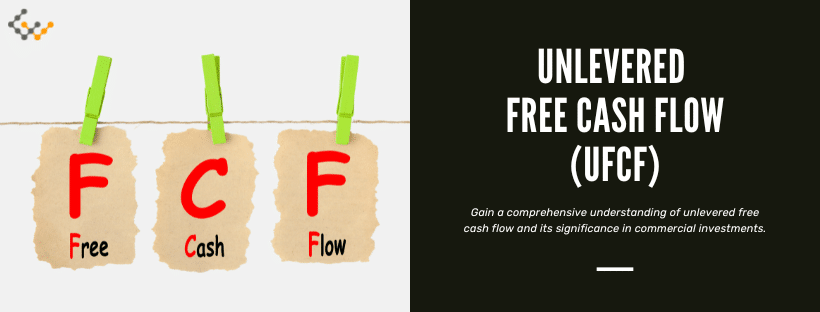What is Unlevered Free Cash Flow in Real Estate?

Real estate investments require evaluation from multiple angles and using multiple metrics. One metric that’s gained increased popularity in recent years is unlevered free cash flow (UFCF). This calculation provides a unique perspective on an investment’s financial performance, focusing on how much cash flow a property generates.
What is an Unlevered Free Cash Flow in Real Estate?
Unlevered free cash flow calculates the cash flow that a commercial investment property generates without considering debt service costs. It represents the cash available from a property’s operations before accounting for interest and principal payments on any loans used to finance the property.
If you were to pay cash for an investment property, UCFC is the amount of cash flow you’d receive from the property.
What is the Purpose of Unlevered Free Cash Flow?
Why use unlevered free cash flow? Unlevered free cash flow isolates an investment property’s cash generation, examining it independent of any financing costs or payments. This gives an undistorted view of a property’s operational performance.
By isolating cash flow independent of financing, investors can compare properties on an “apples to apples” basis, irrespective of their debt structures. This neutral perspective is focused on the property’s inherent ability to generate cash, rather than the method of its financing.
Investors ultimately have to compare potential opportunities taking all costs into account, and levered cash flow must be considered. By first calculating UFCF, however, investors gain a deeper understanding of a property and can perform a more thorough analysis when looking at multiple opportunities.
Levered vs. Unlevered Free Cash Flow: Key Differences
When calculating cash flow, the two main types investors need to know are the levered free cash flow and the unlevered free cash flow. “Cash flow” typically refers to levered free cash flow when unspecified, but it’s useful to calculate each.
Levered Free Cash Flow
Levered free cash flow (LFCF) is the amount of cash a property generates after accounting for all operating expenses and debt service costs. It is, essentially, the cash available to equity holders (owners) after satisfying all financial obligations. All financial obligations includes any obligations to lenders.
The calculation of LFCF provides investors with a realistic picture of the cash that they can extract from a property, considering their debt commitments. This is a more comprehensive calculation than UFCF.
Unlevered Free Cash Flow
In contrast, unlevered free cash flow disregards those debt service obligations and costs. All sources of revenue and all other operating costs (e.g. maintenance, administrative expenses, utilities, etc.) are still included in the calculation.
This calculation allows investors to gauge the cash available for distribution to all stakeholders before considering debt payments. This is a more detailed calculation than LFCF.
Unlevered Free Cash Flow Formula
Calculating unlevered free cash flow first requires knowing net operating income and capital expenditures. Each of these might require some estimations if there’s not a solid track record, or if major changes to an investment property are being considered.
Once these numbers are accurately calculated or projected, the formula for calculating UFCF is relatively straightforward:
Unlevered Free Cash Flow = Net Operating Income (NOI) – Capital Expenditures (CapEx) – Change in Working Capital
Net operating income refers to the income generated from the property’s operations after operating expenses but before accounting for debt service. Capital expenditures (CapEx) are the expenses incurred in maintaining or improving the property, such as repairs, renovations, and upgrades. The change in working capital refers to the fluctuations in short-term assets and (non-financing) liabilities related to the property’s operations.
Unlevered Free Cash Flow Calculation Example
Consider an example of how unlevered free cash flow would be calculated. Suppose a property generates a net operating income of $200,000, and it requires $50,000 as capital expenditures. Assuming there are no changes in working capital, the UFCF would be:
UFCF = $200,000 (NOI) – $50,000 (CapEx) = $150,000
This result implies that the property generates an annual cash flow of $150,000 without considering the costs of any loan obligations.
Benefits and Limitations of UFCF in Real Estate Investment
Unlevered free cash flow brings several advantages to the table for real estate investors. By excluding financing costs the UFCF calculation allows for the following:
- More direct comparison of different properties, even those with varied debt structures.
- More accurate view of a property’s operational profitability, unclouded by financing decisions.
UFCF isn’t without limitations, though. By excluding interest and principal payments, it might portray a more optimistic cash flow than what might be available in reality. For properties financed significantly by debt (which are many investors’ properties), this can result in an overestimation of the actual cash available to owners.
While UFCF can be a valuable tool in the investor’s toolkit, it shouldn’t be the sole determinant of investment decisions. Investors have many calculations to make.
Wrapping Up
Unlevered free cash flow is a valuable tool in assessing the intrinsic cash-generating potential of a real estate property, independent of its financing structure. Even though it isolates a useful metric, however, it shouldn’t be isolated and the sole factor considered.
As you analyze various properties, use UFCF to better compare different opportunities on a property-by-property level without the interference of financing. Make sure to then compare levered free cash flow and other metrics too, though.
Successfully investing in commercial real estate requires a comprehensive analysis of any property purchased or owned. UFCF is one part of that comprehensive analysis that all investors should do.

